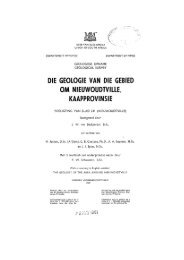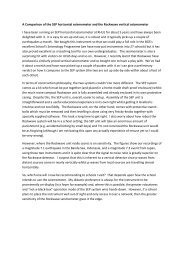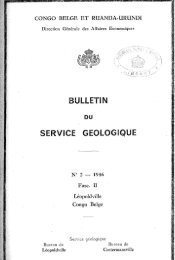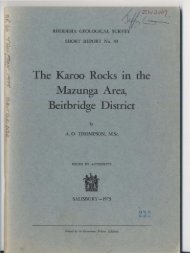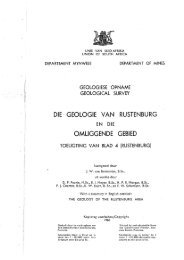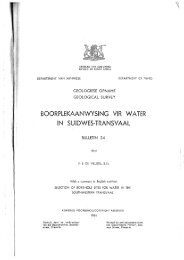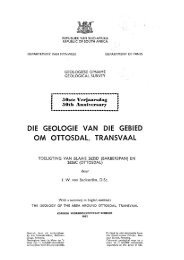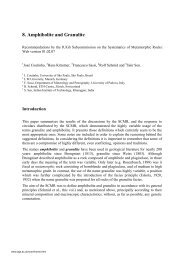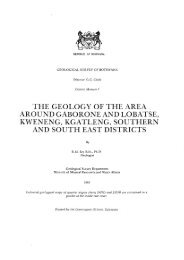Bibliography - British Geological Survey
Bibliography - British Geological Survey
Bibliography - British Geological Survey
You also want an ePaper? Increase the reach of your titles
YUMPU automatically turns print PDFs into web optimized ePapers that Google loves.
Daniel, G. 1974. Perpetrator of the Piltdown forgery. The Times, 18 April, 15. (Takes issue with the confident<br />
assertion of Howard 1974 that the damning evidence provided by the Maresfield map and Pevensey brickstamp<br />
necessarily proves Dawson’s complicity in the Piltdown forgery. ‘There are many who have been<br />
suspected of being the Piltdown forger. My list, apart from Dawson, includes Sir Arthur Smith Woodward,<br />
Professor W. J. Sollas, Horace de Vere Cole, Lewis Abbott, Father Teilhard de Chardin, Sir Grafton Elliot<br />
Smith, A. S. Kennard, W. H. Butterfield and Martin Hinton.’ He expresses the hope that a second revised<br />
edition of Weiner’s The Piltdown Forgery will answer many outstanding questions arising from the Piltdown<br />
affair. Unfortunately Weiner never completed his revision; see Harrison, G. A. 1983. The inclusion of Horace<br />
de Vere Cole in Daniel’s list of suspects was no doubt meant in jest. Cole (1881–1936) was an outrageous<br />
practical joker whose most famous hoax was perpetrated in 1910 (see his entry in Oxford DNB). At best,<br />
Cole’s antics might have given encouragement to the real Piltdown forger.)<br />
Daniel, G. 1975. Editorial [on Leakey, Piltdown, and Teilhard]. Antiquity, 49 (Sept), no. 195, 165–169.<br />
(Recounts Leakey’s suspicions about Teilhard de Chardin’s complicity in the Piltdown affair following the<br />
exposure of the fraud in 1953. Leakey evidently believed that Teilhard had initially played a practical joke<br />
on Dawson, but that the two had then developed the hoax together to test how far the pundits could be taken<br />
in. In 1972 Leakey was engaged in completing a book in which he set out these theories and discussed them<br />
with Glyn Daniel in conversations and letters (some of which are here quoted), but would not be swayed<br />
from his views.)<br />
Daniel, G. 1979. Editorial. Antiquity, 53 (), no. 207, 5. (Reaction to Halstead’s accusation against W. J.<br />
Sollas)<br />
Daniel, G. 1981. Editorial: [a defence of Teilhard against the accusations of Leakey and Gould.] Antiquity,<br />
55 (Mar), no. 213, 2–4.<br />
Daniel, G. 1982a. Editorial: [Kenneth Oakley and Piltdown.] Antiquity, 56 (Mar), no. 216, 7. (Oakley and<br />
the Editor had for the last ten years been in constant correspondence and conversation about the real facts of<br />
the Piltdown forgery. His last letter to the Editor, a few weeks before his death, was concerned with this in the<br />
light of accusations made by Harrison Matthews in 1981. A careful reading of Teilhard’s letters had caused<br />
Oakley to re-think his earlier views about Teilhard’s involvement in the Piltdown affair. See Daniel 1982b.)<br />
Daniel, G. 1982b. Editorial: [Sonia Cole and Joseph Sidney Weiner.] Antiquity, 56 (Nov), no. 218, 164.<br />
(After briefly reviewing the careers of Sonia Cole and Joe Weiner, both of whom died this year, the editor<br />
records that ‘On one thing Le Gros Clark, Weiner, Oakley, Sonia Cole, and the Editor of Antiquity were<br />
agreed: Teilhard de Chardin was not the Piltdown forger, and those like Louis Leakey and Stephen Gould<br />
who thought he was, were gravely mistaken...Teilhard was haunted all through his life by the sad suspicion<br />
which, we believe, in the end amounted to a certainty, that he had been duped by Charles Dawson, the man<br />
who he thought had befriended him. From those who knew him well we know that he did not like to discuss<br />
Piltdown. He would have liked it to be a closed book, but the Le Gros Clark, Weiner, Oakley debunking<br />
opened the book wide, and there was one page which troubled and haunted him to the grave: how was it that<br />
he found the canine? What diabolical machinations lay behind the events of Saturday, 30 August 1913?’)<br />
Daniel, G. 1985. Editorial. Antiquity, 59, no. 227 (Nov), 165–166.<br />
Daniel, G. 1986. Piltdown and Professor Hewitt. Antiquity, 60, no. 228 (Mar), 59‒60. (In response to widespread<br />
publicity and a BBC television broadcast in Newsnight on 22 Nov 1985, which followed Peter Costello’s<br />
revelations in Antiquity no. 227, a letter was received from Mrs Elizabeth Pryce, in which she states that in<br />
about 1952/3 she was told by Prof. John Theodore Hewitt that he and a friend had made the Piltdown man as<br />
a joke. It appears that Hewitt and Woodhead (Costello 1985) were acquainted, and that the latter might thus<br />
have been the ‘other’ person.)<br />
Daniel, G. (see also Johnstone 1957)<br />
Dart, R. 1925. Australopithecus africanus: the man-ape of South Africa. Nature, 115 (7 Feb), 195‒199.<br />
(See subsequent correspondence from Arthur Keith 1925b, who objected to the inference made by Dart that<br />
the Taung skull, Australopithecus, represented the ‘missing-link’ between man and ape)<br />
Davidson, C. F. (see under: Anon. 1954c; Bowie & Davidson 1954a, 1954b, 1955)<br />
Davies, H. N. 1904. The discovery of human remains under the stalagmite-floor of Gough’s Cavern, Cheddar.<br />
Quarterly Journal of the <strong>Geological</strong> Society of London, 60 (3), 335–348, plate XXIX. (In his correspondence



